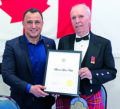Columns » Opinion
FRONT PORCH PERSPECTIVE: Sixth Meeting of the York Region Local Advisory Committee
May 3, 2017 · 0 Comments
By Stephen Somerville
The sixth meeting of the York Region Local Advisory Committee (LAC) took place last Tuesday evening at Brevik Hall in the Aurora Cultural Centre.
According to the Independent Electricity System Operator (IESO), the mandate of the LAC is to provide “advice on the development of the plan’s longer-term options, including innovative solutions that will address the region’s electricity needs. They will also advise on how to best engage the broader community in the discussion.”
The LAC “comprises up to eighteen members, representing municipalities, First Nation and Metis communities, consumers and citizens, the business community, and environmental and conservation groups.”
The LAC has been continuing to meet, and although I have not been able to attend any of the various meetings as a public observer, the published documents provide lots of interesting information, including the presentation from the April 25 meeting.
For context, according to the IESO website a plan has been released for our sub-region:
“In the near-term, three transmission projects are recommended to address capacity and reliability needs; these projects are already under development by Hydro One and PowerStream. In the medium to long term, York Region’s electricity system is expected to reach its capacity to supply growth in the early to mid-2020s based on current projections. If the growth materializes, there will be a need for additional new supply in the region. The Working Group will seek community input on possible solutions.”
The document from the September 21, 2016 LAC meeting provides some key takeaways.
First, on slide twelve, it shows continued growth forecast in Vaughan and Northern York Region over the next twenty years. On the same slide a chart shows approximately 380 MW of incremental growth in the 2015 to 2030 timeframe.
Secondly, on slide 13, “Even with on-going conservation efforts, all three main sources supplying Vaughan and Northern York region will reach their capacity by mid-2020’s.
Third, one of the potential System Reinforcement Options (i.e. transmission and/or distribution lines) is through parts of Aurora, Richmond Hill and Whitchurch-Stouffville.
The notes from the January 24 meeting of the LAC are also interesting.
One of the key takeaways from this document is contained on page three: “Better understanding to what extent can distributed energy resources (DER) be a cost-effective and reliable option to defer the longer-term needs in Northern York Region/Vaughan.
Slide 27 includes examples of DERs: small gas-fired generators, micro-grids, energy storage, combined heat and power for business, residential demand response and renewable generation like solar.
As it states on page 29: “As an alternative to transmission and distribution solutions, DERs can provide a local source of supply for communities.”
But there is a lot of work to do to see if some or all of these potential DERs can work. Otherwise, either new or enhanced transmission/distribution line(s) running through Aurora may be in our future at some point.
There were three principle objectives for the April 25 meeting:
First, provide an update on near-term projects and activities to prepare for the next iteration of the York Region Electricity Plan. Second, discuss approaches to gather community input on the York Region electricity planning activities. Third, provide an overview of the Environmental Assessment (EA) process and engagement opportunities.
Some of the major takeaways from the April 25: presentation:
There is no change from the presentation made in January regarding growth projections. From slide five: “By mid-2020s growth in Vaughan and Northern York Region will exceed electricity system’s capability.”
Second, the Technical Working Group needs to determine the cost and feasibility of using DER/non-wires solutions to manage longer term growth in York Region.
Third, community input will be important and the LAC is considering how best to do this.
Fourth, and most interesting is agenda item #8, “Environmental Assessment Process & Engagement.” The next few slides are regarding the Class Environmental Assessment Process for Minor Transmission Facilities.”
So, this much is clear in my mind at this point.
Our communities continue to experience lots of growth for the foreseeable future, and the IESO and the Technical Working Group are very much hoping that a local DER solution will work, otherwise we need to study transmission line options.
As someone who has made a living in the electricity sector for the last 17 years and as someone who has watched the generation versus transmission line alternatives play out in other areas of this province, I have two pieces of advice:
First, to my fellow Aurorans, become fully engaged early on in this process, as the various options can have big impacts on our community.
Second, to the Technical Working Group: As early as you can in this process, you need to lay out the alternatives side by side – DER versus transmission – in a clear, and easy to understand way. This comparison chart needs to include the costs, the various impacts and the timelines.
Stephen can be contacted at stephengsomerville@yahoo.com











